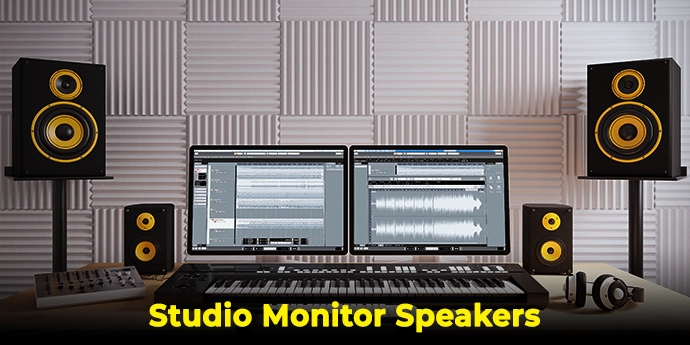Table of Contents
What are Studio Monitor Speakers?
Studio monitor speakers, also known as reference monitors or studio speakers, are a type of high-quality loudspeaker system specifically designed for use in audio recording, mixing, and production environments, such as recording studios, home studios, and professional audio production facilities. These monitors are an essential tool for audio professionals, including music producers, sound engineers, and musicians, as they provide accurate and uncolored sound reproduction, allowing for precise monitoring and critical listening during the recording and mixing processes.

Timeline of a Studio Monitor:
In the early days of the recording industry, around the 1920s, studio monitors served a basic purpose: to identify noise interference and technical issues. These early monitors were essentially basic loudspeakers. The development of high-end studio monitors can be traced back to the movie production industry. In 1944, a significant milestone was reached with the introduction of the Altec Lansing Duplex 604, which was specifically designed as a studio monitor. Over the next 25 years, the Altec Lansing 604 became the industry standard, undergoing over eleven model modifications.
As time passed, the Altec Lansing monitors were eventually succeeded by another prominent brand – JBL. The 1980s witnessed the rise of soft-dome monitors in the studio monitor landscape. By the 2000s, there was a shift in focus towards “translation.” This meant that engineers began choosing monitors not just for accuracy but also for their ability to translate well across various playback systems, such as car radios and boomboxes.
Types of Studio Monitors:
There’s a wide variety of monitors available, differing in size, shape, color, and price. They can be categorized as “Active” or “Passive.” Passive monitors require an external amplifier and crossover to be connected to the speaker, while active monitors have everything built-in, and you only need to connect them to your source.
For home use, most monitors are around 5 inches in size, as larger speakers can be too loud, potentially causing issues with neighbors unless your home is soundproofed. So, 5-inch monitors are usually recommended for home studios. In contrast, professional studios often use 8-inch or larger monitors.
Monitors can also be classified as “near field” or “far field.” Near field monitors are designed for listening at close distances and are typically placed on stands or a desk. Far-field monitors, on the other hand, are usually wall-mounted.
Additionally, there are subwoofers, which are used to hear the low-frequency components of a mix. These are typically employed after a mix is completed to assess how everything blends together. However, subwoofers should be used cautiously during mixing because they can easily affect the balance between treble and bass. So, it’s common to introduce the subwoofer only in the final stages of the mixing process.
Features & Characteristics of Studio Monitor Speakers
- Accuracy: Studio monitor speakers are designed to reproduce sound as accurately as possible without adding coloration or distortion. This accuracy helps audio professionals make informed decisions about sound recording, mixing, and production.
- Bi-Amping or Tri-Amping: Higher-end studio monitors may feature separate amplifiers for different speaker components (e.g., tweeters and woofers), allowing for more precise control over the individual frequency ranges and improving overall sound quality.
- Different Sizes and Configurations: Studio monitors come in various sizes and configurations, including two-way (woofer and tweeter) and three-way (woofer, midrange, and tweeter) designs. The choice of monitor size and configuration depends on the specific requirements of the audio production tasks.
- Active (Powered) or Passive: Studio monitors can be either active (powered) or passive. Active monitors have built-in amplifiers, simplifying the setup and ensuring that the amplifier’s characteristics match the speakers. Passive monitors require external amplification.
- Placement and Acoustic Treatment: Proper placement of studio monitors and acoustic treatment of the listening environment are essential for achieving accurate sound reproduction. Room reflections, standing waves, and other acoustic issues can affect the perceived sound, so audio professionals often invest in acoustic treatment materials and proper monitor placement.
- Multiple Input Options: Studio monitors typically offer various input options, such as XLR, TRS, and RCA connectors, to accommodate different audio sources and equipment.
Studio monitors are specialized speakers designed for critical audio monitoring in recording and production environments. They prioritize accuracy and transparency, providing audio professionals with a reliable tool for creating and refining high-quality sound recordings and mixes.
Things to keep in mind while purchasing Studio Monitor Speakers
When you’re in the market for studio monitor speakers, there are several vital specifications to consider to ensure optimal performance. These encompass:
- Wide Frequency Range: It’s crucial to verify that the monitors can handle the complete frequency range of your recordings to maintain accuracy. A typical frequency response for most recording tasks falls within the range of 40Hz to 20kHz.
- Total Harmonic Distortion (THD): THD measures the cleanliness of a monitor’s audio reproduction. A pristine audio circuit should exhibit a THD+N (Total Harmonic Distortion plus Noise) of approximately 0.001%. Conversely, a poorly designed circuit can introduce noticeable distortion, typically falling within the range of 0.3% to 1%.
- Wattage: While not as critical in studio settings, monitor power is quantified in watts. For smaller studios, a range of 10 to 60 watts should suffice.
- Near-, Far-, or Mid-field Design: The “nearfield” designation pertains to monitors placed near the user or listener, typically just a few feet away. This configuration offers a clear, immediate sound and minimizes the listener’s exposure to natural reverberations. Near-field monitors, featuring compact speakers, are well-suited for most studio applications because they enable the listener to predominantly hear the sound directly emitted from the speakers, as opposed to sound bouncing off walls and ceilings.
In addition to these critical specifications, it’s imperative to consider the monitor type, such as active or passive models, and assess the dimensions and acoustics of the room in which they will be employed. Furthermore, the correct positioning and angling of the monitors play a pivotal role in ensuring precise sound reproduction.
Studio Monitors Vs. Studio Speakers
Studio monitors and speakers may appear similar, but they serve distinct purposes in the world of audio. Here’s the breakdown:
Studio Monitors:
- Purpose: Designed for critical listening during recording, mixing, and mastering.
- Sound Objective: Intended to reveal sonic imperfections for precise adjustments.
- Technical Differences:
- Active: Typically powered with built-in amplifiers.
- Individual Power Amps: Each speaker component (woofer, midrange, tweeter) has its dedicated power amplifier for precision.
- Crossovers: Employed to split frequencies for accurate delivery to the right speaker component.
- Sound: Strive for a flat, precise sound for nearfield use, not emphasizing any specific frequency.
Speakers:
- Purpose: Aimed at delivering enjoyable sound in various spaces.
- Sound Objective: Prioritize sounding good in different environments.
- Technical Differences:
- Active/Passive: Often passive, requiring external amplification.
- Sound: Tailored for good sound quality in various settings and listening positions.
Nearfield Monitors:
- Definition: Positioned close to the listener, typically a few feet away.
- Sound Objective: Provide a clear, immediate sound without natural reverberations, allowing precise monitoring.
Regular Speakers (Far-Field):
- Definition: Designed to sound good in different rooms and from various directions.
- Sound Objective: Aim for pleasing sound quality in any room and listening position.
- Using Regular Speakers as Studio Monitors:
- While not ideal, some producers use regular speakers like Yamaha NS10 for their unique ability to reveal inconsistencies in sound.
- Using Studio Monitors for Home/Hi-Fi Use:
- Studio monitors are designed for specific distances and perspectives, so their sound may vary as you move around.
- They may not provide the best experience for casual home listening.
- Studio headphones are a closer match to studio monitors for accurate audio impressions during mixing and mastering. Avoid standard headphones for critical mixing.
How to Arrange Studio Monitors in a Home Studio?
To properly set up your studio monitors in a home studio, follow these steps:
- Ensure Equal Distance: Begin by checking if the monitors are positioned at an equal distance from each other. Also, make sure your seating position is at the same distance from the monitors. This helps create a balanced listening environment.
- Adjust the Angle: The angle at which you position the monitors can significantly affect the sound. Studies have shown that a 30-degree angle for the speakers works best for optimal listening. This angle enhances the listening experience.
- Consider Mounting: To minimize unwanted sound reflections, consider mounting the monitors. Placing monitors directly on a desk can impact the sound quality, as the sound travels through the desk before reaching your ears. Mounting the monitors or using stands can help improve sound clarity.
By following these steps, you can set up your studio monitors effectively in your home studio, creating an ideal listening environment for your audio work.









